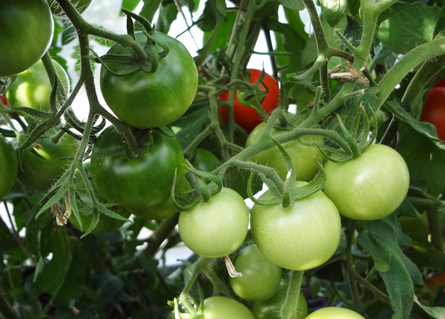Tomatoes’ tasteless green gene
Choosing tomatoes for color reduces fruit’s flavor, study finds
Share this:
- Share via email (Opens in new window) Email
- Click to share on Facebook (Opens in new window) Facebook
- Click to share on X (Opens in new window) X
- Click to share on Pinterest (Opens in new window) Pinterest
- Click to share on Reddit (Opens in new window) Reddit
- Share to Google Classroom (Opens in new window) Google Classroom
- Click to print (Opens in new window) Print
By Roberta Kwok
The tomatoes your great-grandparents ate probably tasted little like the ones you eat today. The fruit used to have more flavor. A lot more flavor. In fact, tomatoes “were once so flavorful that you could take one in your hand and eat it straight away just like we regularly eat apples or peaches,” according to plant scientist Alan Bennett. He belongs to a team of international scientists who now think they know one reason why the fruit has lost so much flavor.
Although some unripe tomatoes have a dark green patch near the stem, farmers prefer that their unripe tomatoes are the same shade of green all over. The consistent coloring makes it easier for them to know when the fruit should be picked.

But tomatoes without the dark green patch are also missing an important genetic ingredient that helps the fruit make more sugar and other tasty molecules. So by breeding tomatoes for that consistent color, Bennett’s team says, crop scientists may have accidentally contributed to also making this fruit bland.
“It is a good illustration of unintended consequences,” Harry Klee told Science News. Klee studies tomato flavor at the University of Florida in Gainesville.
Tomatoes make sugars in compartments called chloroplasts. Bennett, who works at the University of California, Davis, and his colleagues found that tomatoes need the correct version of a particular gene (one called SlGLK2) to form chloroplasts properly in the fruit. A gene acts as a biological instruction book that tells cells which molecules to make.
Tomatoes without the dark green tinge have the wrong version of this gene, the researchers report in the June 29 issue of Science. As these fruit ripen, they can’t make as many chloroplasts. And chloroplasts that they do produce are smaller. One result: The tomatoes make less sugar — and don’t taste as good.
Tomatoes also produce gases responsible for some of the odors we associate with the fruit. Even though you only breathe them, these gases affect the way that you perceive flavor. Tomatoes with weak chloroplasts can’t make as much of these gases, further reducing flavor.
But the newfound gene change is “not the whole story of why modern tomatoes are so bad, by a long shot,” Klee told Science News. Tomatoes also taste blander when they are picked too early or stored in the fridge.
Power Words
gene An instruction in an organism’s cells that instructs the cell on which molecules to make.
chloroplast A compartment in a plant cell that turns carbon dioxide and water into sugar and oxygen.







